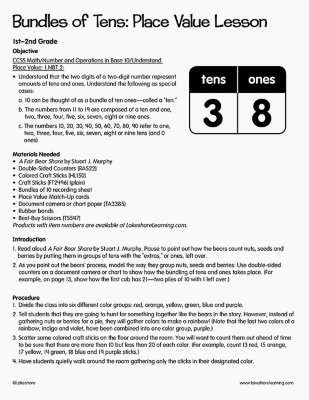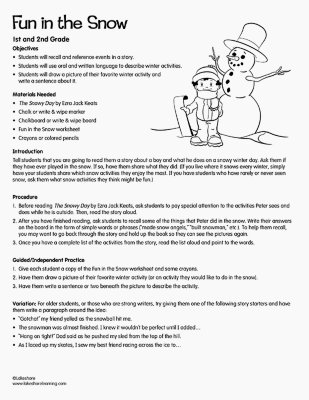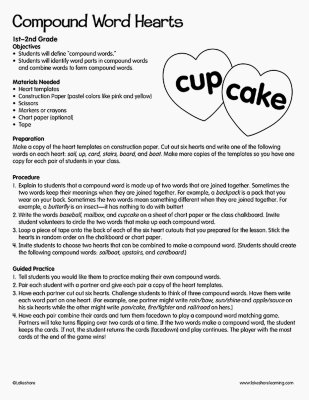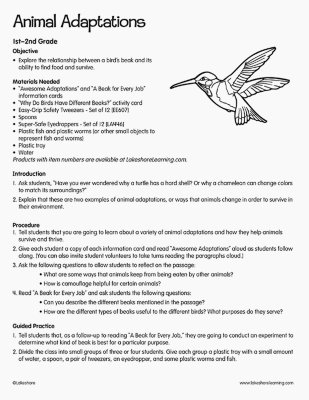Narrow by Grade
- Infant (0)
- Toddler (0)
- Preschool (0)
- Pre-K (0)
- Kindergarten (0)
- 1st (4)
- 2nd (4)
- 3rd (0)
- 4th (0)
- 5th (0)
- 6th & Up (0)
Grade
Narrow by Age
- 0-18m (3)
- 18-36m (4)
- 3 yrs. (0)
- 4 yrs. (11)
- 5 yrs. (9)
- 6 yrs. (6)
- 7 yrs. (4)
- 8 yrs. (2)
- 9 yrs. (2)
- 10 yrs. (2)
- 11 yrs. & Up (0)
Age 7 yrs.
4 results for "colored"
Filters
Clear All
Bundles of Tens: Place Value Lesson
1st Grade - 2nd Grade
Objective CCSS Math/Number and Operations in Base 10/Understand Place Value: 1.NBT.2: Understand that the two digits of a two-digit number represent amounts of tens and ones. Understand the following as special cases: 10 can be thought of as a bundle of ten ones—called a “ten.” The numbers from 11 to 19 are composed of a ten and one, two, three, four, five, six, seven, eight or nine ones. The numbers 10, 20, 30, 40, 50, 60, 70, 80, 90 refer to one, two, three, four, five, six, seven, eight or nine tens (and 0 ones). Materials Needed A Fair Bear Share by Stuart J. Murphy Double-Sided Counters Colored Craft Sticks Craft Sticks (plain) Bundles of 10 recording sheet Place Value Match-Up cards Document camera or chart paper Rubber bands Best-Buy Scissors Introduction Read aloud A Fair Bear Share by Stuart J. Murphy. Pause to point out how the bears count nuts, seeds and berries by putting them in groups of tens with the “extras,” or ones, left over. As you point out the bears’ process, model the way they group nuts, seeds and berries: Use double-sided counters on a document camera or chart to show how the bundling of tens and ones takes place. (For example, on page 13, show how the first cub has 21—two piles of 10 with 1 left over.)
View Lesson PlanFun in the Snow
1st Grade - 2nd Grade
Objective Students will recall and reference events in a story. Students will use oral and written language to describe winter activities. Students will draw a picture of their favorite winter activity and write a sentence about it. Materials Needed The Snowy Day by Ezra Jack Keats Chalk or write & wipe marker Chalkboard or write & wipe board Fun in the Snow Worksheet Crayons or colored pencils Introduction Tell students that you are going to read them a story about a boy and what he does on a snowy winter day. Ask them if they have ever played in the snow. If so, have them share what they did. (If you live where it snows every winter, simply have your students share which snow activities they enjoy the most. If you have students who have rarely or never seen snow, ask them what snow activities they think might be fun.)
View Lesson PlanCompound Word Hearts
1st Grade - 2nd Grade
Objectives Students will define “compound words.” Students will identify word parts in compound words and combine words to form compound words. Materials Needed Heart templates Construction Paper - 9" x 12" (pastel colors like pink and yellow) Scissors Markers or crayons Chart paper (optional) Tape Preparation Make a copy of the heart templates on construction paper. Cut out six hearts and write one of the following words on each heart: sail, up, card, stairs, board, and boat. Make more copies of the templates so you have one copy for each pair of students in your class.
View Lesson PlanAnimal Adaptations
1st Grade - 2nd Grade
Objective Explore the relationship between a bird’s beak and its ability to find food and survive. Materials Needed “Awesome Adaptations” and “A Beak for Every Job” information cards “Why Do Birds Have Different Beaks?” activity card Easy-Grip Safety Tweezers - Set of 12 Spoons Super-Safe Eyedroppers - Set of 12 Plastic fish and plastic worms (or other small objects to represent fish and worms) Plastic tray Water Introduction Ask students, “Have you ever wondered why a turtle has a hard shell? Or why a chameleon can change colors to match its surroundings?” Explain that these are two examples of animal adaptations, or ways that animals change in order to survive in their environment.
View Lesson Plan


